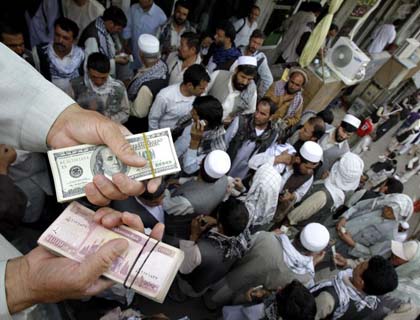Just stepping inside Kabul’s luxuries shopping malls, we can get the feeling that indeed costumers are not spending as they used to. Though there will be soon Eid celebration, in which Muslims generally spend too much for necessary as well as luxury goods, but this year it seems that Afghan people are trying to celebrate it with lesser expenses. Talking to shop owners, they are not happy with their revenue this year and complaining about lack of costumers and overall average sales rate. Many are saying that the average sales rate decreased to half over the same period last year.
Few days ago, I was standing by roadside waiting for taxi to go to bazaar. A private motorbike stopped nearby and told me if our direction was one. He told me that he run a private business, a foreign chocolate wholesales man. He told me that last year before the Eid festival, he sold three truckloads of chocolate and his reservoirs finished and faced shortage for Eid days.
“I could not supply for many of costumers last year. The market was vibrant and demand too high. But this year, everything is a pathetic situation. I have imported two trucks of chocolate this year and still could not sell half of them. All my costumers also have similar situation and their reservoirs are full”. He was saying there was no hope that the ill market recovers soon.
He continued, “If the situation goes like this, there is no need of Taliban to destabilize the country. Warlords and influential people who kept their mouth shut merely for engulfing millions of dollars during past eleven years, will turn back their own tradition---kidnapping, stealing and grasping people’s goods and properties”.
Anyhow, it should be noticed that economy has recovered somehow from decades of conflict. Indeed it has improved significantly since the fall of the Taliban regime in 2001, largely because of the infusion of international assistance, the recovery of the agricultural sector, and service sector growth. No doubt, the Afghan economy is largely based on the agriculture, despite the fact that only 12% of its total land is arable and less than 6% is currently cultivated.
Meanwhile agriculture production is constrained by an almost total dependence on erratic winter snows and spring rains for water. Annually, the country’s fruits and nut exports become tens of millions of dollars. The country is also well known for producing some of the finest fruits, especially pomegranates, apricots, grapes, melons, and mulberry.
Several provinces in the north of the country are famous for pistachio cultivation but the area currently lacks proper marketing and processing plants. Wheat and cereal production is Afghanistan's traditional agricultural mainstay. The overall agricultural production dramatically declined following four years of drought as well as the sustained fighting and instability in rural areas.
Another economic mainstay is livestock. The availability of land suitable for grazing has traditionally made animal husbandry an important part of the economy. There are two main types of animal husbandry: sedentary, practiced by farmers who raise both animals and crops; and nomadic, practiced by animal herders known as Kuchis.
Oxen are the primary draft power and farmers often share animals for plowing. Much of Afghanistan's livestock was removed from the country by early waves of refugees who fled to neighboring Pakistan and Iran. In 2001, the livestock population in Afghanistan had declined by about 40% since 1998. In 2002, this figure was estimated to have declined further to 60%.
The great majority of Afghans traditionally raise sheep instead of goats because goat meat is not popular in Afghanistan. After the establishment of new government, the Afghan Ministry of Agriculture and livestock and USAID have been helping to re-grow the number of livestock throughout the country. This is done by providing Afghan villagers training and animals to start with.
But no doubt, considering the current state of the country and growing population rate along busting urbanization process, Agriculture and animal husbandry are not something Afghans set eyes as source for prosperity. Even those also depended largely on infusion of foreign financial assistance, which has already decreased tremendously.
Despite the progress of the past few years, Afghanistan is extremely poor, landlocked, and highly dependent on foreign aid. Much of the population continues to suffer from shortages of housing, clean water, electricity, medical care, and jobs. Criminality, insecurity, weak governance, and the Afghan Government's difficulty in extending rule of law to all parts of the country pose challenges to future economic growth. Afghanistan's living standards are among the lowest in the world.
During past years, cash downpour in the country pulled many out of poverty and the economy boomed as annual economic growth put by Afghan government more than 10 percent. The question is that growth sustainable? Looking to declining investment and a dwindling market, the answer is unfortunately negative. No matter, how the international community is trying to convey message of long-term commitment, but the level of foreign donations is declining and makes the economy stagnant.
The only hope is foreign investment in infrastructure and huge natural resources. That of course largely depends on political situation. People are seriously worried about post-2014. If the situation does not get better, then we should await for reversal of economy which will end to a start of self-fuelling disaster.

